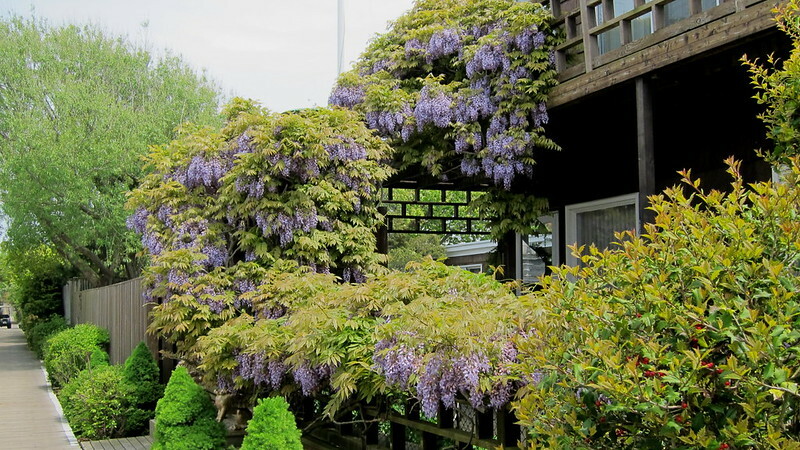Wisteria is possibly the most coveted flowering vine amongst gardeners. The long limbs, dripping with blue, purple, or white flowers, are signs of the spring melting into the warmer days of summer. Painters and writers depict the fragrant flower bundles draped across the facade of a stately home or shading stone pathways. Even with all of the pomp and circumstance surrounding Wisteria, at its core this is one easy-to-grow vine.

Photo by K M, unmodified, Flickr, copyright CC BY 2.0 DEED
Grow Wisteria where it will receive at least 6 hours of direct sun exposure. Wisteria is part of the legume family and is able to extract nitrogen from the air and store it in its root nodules. This ability means Wisteria rarely needs supplemental fertilizing. Although it needs regular water when young, no supplemental watering is typically needed once it is old enough to flower.
Ensure that Wisteria has an extremely sturdy structure in place at the time of planting. Attempting to train Wisteria even a couple of years after planting can be an exercise in frustration, involving severe pruning to rejuvenate limbs that are suitable for training.
Shrubs To Plant With Wisteria
Broadleaf evergreen shrubs, such as rhododendrons, azaleas, and daphne, make great companions for Wisteria. These shrubs have naturally attractive shapes that rarely need pruning, and produce early spring flowers that make a lovely segway into the flowering season of Wisteria. In front of Wisteria, formal plantings with yew, boxwood, blue spruce, or holly can provide an extra layer of texture between the vine and possibly a low-growing layer of herbaceous perennials or annuals. Use deciduous flowering shrubs like butterfly bush, hydrangea, viburnum, or spirea to cover the bare trunk of Wisteria and add color long after the vine has stopped blooming.
Perennials To Plant With Wisteria
The perennials planted alongside Wisteria need to be vigorous growers, able to contend with the temporary overgrowth of a Wisteria through the summer. Early bloomers like alliums, lady’s mantle, and hardy geranium can hold their own against Wisteria. Their open growth habits can create lovely combinations of foliage and color in a cottage garden.

Photo by Mark Wordy, unmodified, Flickr, copyright CC BY 2.0
Other less aggressive perennial vines are great partners for a Wisteria growing in a naturalized area of the garden. Choose from clematis, akebia, and honeysuckle, which all bloom after Wisteria and add lovely color and scent for the rest of the summer.
Annuals To Plant With Wisteria
Groundcovers with shallow roots are great for suppressing weed growth near Wisteria. Annuals with a reputation for generous self-seeding include California poppies, forget-me-nots, calendula, sweet alyssum, and bachelor's buttons. These cheerful bloomers will reappear year after year and will stay within the growing area as long as unwanted seedlings are lightly edited. These annuals also demand little nutrition in the soil and are fairly drought tolerant once they become established early in the spring.

Photo by Mark Wordy, unmodified, Flickr, copyright CC BY 2.0
Best Companion Plants For Wisteria in Containers
The large root system of Wisteria makes it difficult to grow in a container for more than a few years. Container-grown Wisteria may never mature enough to bloom successfully, so it is generally recommended to plant Wisteria in the ground.
Plants Not To Grow With Wisteria
Slow-growing shrubs and perennials, and annuals with fragile stems do not pair well with the more aggressive-growing Wisteria. Over the course of one summer, Wisteria can completely overtake outdoor structures if left unpruned or unmanaged. Wisteria growing unchecked in trees may eventually seriously damage the limbs or strangle the trunk.
The best way to remove an overgrown Wisteria is to cut off the vine at the base and remove any branches that are reachable from the ground. The top growth will die back on its own, preventing any further harm to a tree’s limbs or overall structure.
Best Plants To Grow With Wisteria
The stunning vines of Wisteria rate high on most gardeners’ bucket lists. Maintaining Wisteria is not difficult if done on a schedule throughout the growing season. Many shrubs and perennials can be effectively grown as facer plants for the often naked lower trunk. Choose shrubs with an open habit, like viburnum, spirea, and rhododendron, for an informal look, or use manicured evergreen shrubs, like boxwood, arborvitae, and yew, for more formal designs.
Sources: “Genus: Wisteria - Go Botany - Native Plant Trust.” Native Plant Trust. gobotany.nativeplanttrust.org
